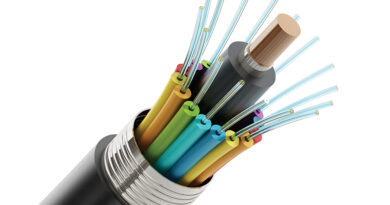Remote PHY Distributed Access Architecture
By Steven Harris
Cable operators continue to find ways to enhance the service delivery network with a keen focus on reliability and increased capacity.
Bandwidth capacity demands from our customers continue to grow rapidly, putting pressure on existing infrastructures like the HFC access network with analog optics. In my previous articles we explored the fiber deep and fiber to the x (FTTx) architectures that are evolving the HFC platform. The fiber deep or node + 0 architecture does not utilize active devices in the last mile (that is, there are no actives after the node) of the access network, while pushing fiber and an optical node within a few hundred or thousand feet from the customer premises. FTTx architectures similarly move fiber closer to the customer premises, perhaps to the curb (FTTc), business (FTTb), or home (FTTh). Performance based fiber deep and FTTx architectures may operate over a centralized access architecture (CAA) where the CMTS, dense video edge QAM modulator and physical networking are all located at the headend or hub.
An improved data and video delivery option for operators is the converged cable access platform (CCAP), joining the functions of the CMTS, physical networking and dense video edge QAM modulator together. The CCAP permits data to be handled over IP prior to the typical RF or analog optical conversion for transport over the access network. A few of the CCAP design benefits include reducing the physical functionality required at the headend, more efficient powering, an increase in headend density, ability to scale the digital network and streamlining the management of these services. However, CCAP is not an end solution, as architectures like fiber deep increase the number of optical nodes in an access network and the demand on CCAP port density. FTTx also requires additional PHY devices at the headend, typically where little additional space or power exists for all the additional equipment.
Another appealing network modification operators are considering in the service delivery network is the distributed access architecture or DAA. In DAA, the physical (PHY) and media access control (MAC) layers of a CCAP may be split between the headend and an access network optical node.
In DAA, the devices or the MAC and PHY layer functions of a CCAP may be placed entirely in the optical node housing, access network cabinet, or even a multiple dwelling unit (MDU). There are three approaches to DAA that have been circulating. These are remote PHY (R-PHY), remote PHY and MAC, and split MAC. R-PHY moves the physical layer components of the CCAP into the access network. R-PHY and MAC move both layers into the access network. The split-MAC is where part of the MAC functionality is defined and remains at the headend and the remaining MAC (also called R-MAC/PHY) and PHY functionality are moved to the access network node. The focus of the remainder of the article is R-PHY.

At SCTE·ISBE Cable-Tec Expo 2017, R-PHY was a very popular and well attended session this year. R-PHY looks to be the first DAA that will be deployed by cable operators, due largely to its relative ease of deployment and support by the vendor community. The PHY layer is the bottom layer (Layer 1) of the Open Systems Interconnection reference model or OSI model. The PHY layer refers to the physical hardware and connections that move information around a cable network. In the case of an HFC access network, the PHY layer includes the optical fiber, coaxial cable, optical transmitters, optical receivers, RF amplifiers, RF modulators and RF demodulators that move the cable bits across the network. R-PHY extends the current CCAP architecture in which the PHY circuits are removed from the CCAP. The PHY circuits are relocated to the access network into a separate R-PHY device (RPD) which is located in a standalone chassis called a shelf, or in a node. After the PHY is relocated, the CCAP core remains, along with the MAC and upper layers.
The RPD converts downstream DOCSIS, MPEG and OOB signals received from the CCAP core over a digital medium such as Ethernet or a passive optical network (PON) to analog for transmission over RF or linear optics. In addition, in the upstream, the RPD converts customer DOCSIS, MPEG and OOB signals received from an analog medium to digital for transmission over Ethernet or PON to a CCAP core. In this design, the RPD contains mainly PHY related circuitry, such as downstream modulators and upstream demodulators together with pseudo-wire logic to connect the RPD to the CCAP core using a Layer 2 or Layer 3 network.
The CCAP core supports the non-RF functions of MPEG video and the CMTS for DOCSIS data. Inside the CMTS, support for DOCSIS 3.0 and DOCSIS 3.1 MAC functions exists, along with the downstream and upstream bandwidth scheduling, and DOCSIS framing. All the video processing functions that a dense edge QAM modulator provides in a cable network are handled by the CCAP core.
R-PHY DAA provides a more efficient headend and improved design architecture with better network performance for a shared fiber infrastructure in commercial and residential customer networks. DAA offers lower cost dense optics, improved operational expenses (OpEx), and eliminates distortions in the optical path. With technologies like R-PHY operators may also expect improved dynamic range and RF metrics such as a higher modulation error ratio (MER), making higher modulation orders (e.g. 4096-QAM) possible. The R-PHY DAA offers a huge advantage for operators by using digital fiber links between the headend and R-PHY node, resulting in better signal quality in the coax plant. In fact, R-PHY DAA is also a great foundation for DOCSIS 3.1 and next generation DOCSIS known as full duplex (FDX) DOCSIS, offering improved CCAP port scaling, up to 10x the port density. R-PHY is an enabler for virtualization, a first step for the access network. R-PHY uses the generic control plane (GCP) protocol to carry data elements to manage the initialization and operation or control plane of the RPD. Lastly, the use of digital fiber allows support for more wavelengths per fiber, digital fiber deep networks and a clear path for FTTx future deployment.
The R-PHY DAA is yet another evolution in DOCSIS data and MPEG video delivery for cable operators. As mentioned DAA is a modification to the CCAP architecture in which R-PHY relocates Layer 1 physical circuits to a RPD in the access network. In addition, a DAA supports two other future options called remote MAC/PHY and split-MAC. In R-PHY, the MAC layer remains at the headend or hub site in the CCAP core. The CCAP core connects to the R-PHY device in the access network using pseudo-wire technology that extends the Ethernet or IP network. With the many advantages of R-PHY in the network, be prepared to see and hear more about this exciting technology. At SCTE® • ISBE® you may prepare yourself for the future optics in cable networks. Learn more at http://www.scte.org/courses.
 Steven Harris
Steven Harris
Senior Director, Advanced Network Technology and Instruction, Learning and Development, SCTE•ISBE
Steve Harris is the senior director of advanced network technology and instruction at SCTE•ISBE. He is a respected international telecommunications subject matter expert, sought-after presenter and principal instructor. He is responsible for the tremendous growth of SCTE•ISBE training programs and certifications for over 100,000 telecommunications professionals. He also has responsibility for the client partnership in the SCTE•ISBE Corporate Alliance Program for cable operators and vendors.
Source: SCTE•ISBE, Shutterstock



